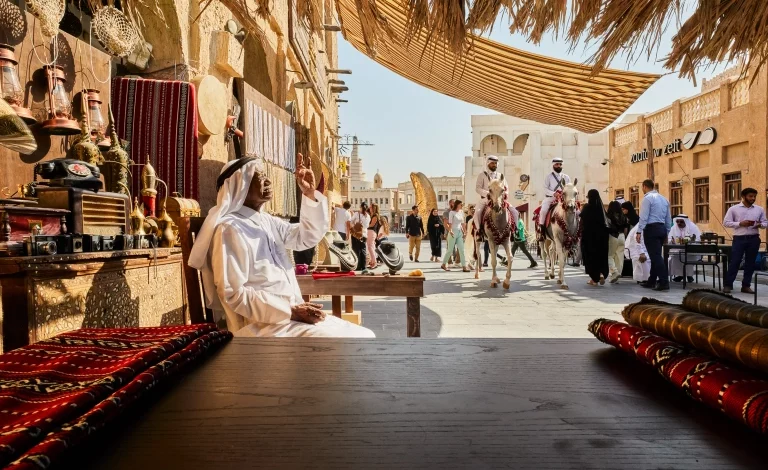The Last Pearl Diver in Qatar

“I’m an old pearl diver. This last week, Friday, I was in the sea diving. From when I am 15 years old up to now, I am a pearl diver and bodybuilder.”
The store owner motions to a framed black-and-white photograph on the wall behind him. My gaze shifts between the slender, elderly man in front of me and the image of a toned, shirtless young man with fur draped over his shoulder like a toga. The former looks like someone’s unassuming grandfather; the latter looks like a warrior.
The store owner nods at a gentleman behind the counter, as if he can sense I need more visual proof to accept his claims. The man presses play on a remote, and the flat-screen TV in the corner, low under shelves filled with seashells and hanging pearl strands, comes to life.
“I lay down on steel nails. I lay down on broken glasses. They break stones on my chest,” the store owner states matter-of-factly, narrating the events unfolding on the screen as I watch in disbelief. “I can do it anytime, and my age is 87 years old. That’s myself, diving and collecting oysters from the bottom of the sea.”
I realise I am talking to a real-life strong man. Or as he’s known in Souq Waqif, the last pearl diver in Qatar.
There are few men still alive who can say they were once professional pearl divers. Saad Ismail Jassim, who runs a shop in Souq Waqif, Doha’s busiest market, is one of them.
Pearl diving was once Qatar’s largest industry and is a tradition ingrained in the nation’s history and culture. You’ll find nods to Qatar’s pearl diving past throughout the capital city of Doha, including dhow boats at the harbour, traditionally used for collecting pearls, and The Pearl Monument, an open oyster shell statue with a pearl inside.
Starting in the 1920s, the introduction of artificial pearls by Japan and the discovery of mineral fuels in Qatar made pearl diving obsolete. This was probably for the best, as pearl diving was a wildly dangerous undertaking.
Boats were on the water for months at a time during the summer season, resulting in malnourishment and illness from unhygienic conditions. Free divers were required to descend rapidly to the sea bottom, holding their breath, before being suddenly hauled out. They maximised their time in under the water, which could cause blackouts or in some cases, brain damage. And for most divers, the pay was scarcely worth the effort.

“Any pearl, in the old days, I find, I sell and then I eat. I would not keep it for him to see or you. I sell to eat. I’m not keeping it in my pocket and dying of hunger,” says Jassim, describing the mindset of most divers. While gulf pearls were lucrative in trade, diving was hard work and profits failed to trickle down to those who did the harvesting.
Pearl merchants, on the other hand, would sometimes hold on to a pearl for many years waiting to acquire an identical match. Pearls were classified and valued according to their size, shape, colour and lustre, and matching pearls or whole sets of matching pearls were more valuable than one pearl alone.
Today, Jassim uses scuba gear for recreational diving but still has his traditional tools on display. Only three items were required to dive: a nose plug, a weight to tie around one ankle and a net to collect the oysters. Jassim demonstrates how he used them all, happy to recount his life story to visitors at the shop. He’s had many, including the Sheikh himself.
Relics of Qatar’s pearl diving history have found new life in one of the country’s most modern attractions—The National Museum. The stunning complex is an architectural feat, made of hundreds of interlocking discs in the image of a desert rose.
Inside you’ll find expertly curated exhibits documenting Qatar’s history from the beginning of time until now. Gulf pearls play a crucial role in the narrative, and there are many priceless pieces on display.
Chief among them is the Pearl Carpet of Baroda, commissioned by the Maharaja of Baroda in India to adorn the Prophet Muhammad’s tomb in Medina. It has over 1.5 million inlaid gulf pearls, and bears other precious jewels, including diamonds, emeralds, rubies and sapphires—each of which had to be individually pierced and sewn onto the carpet. The design of curved flowers and leaves resembles nothing so much as a heavenly garden.

While Qatar has experienced rapid development and growth over the last century, its pearl diving tradition, sustained for now in those who, like Jassim, lived it, remains an ever-present reminder that it was culturally rich long before becoming one of the wealthiest countries on earth.




